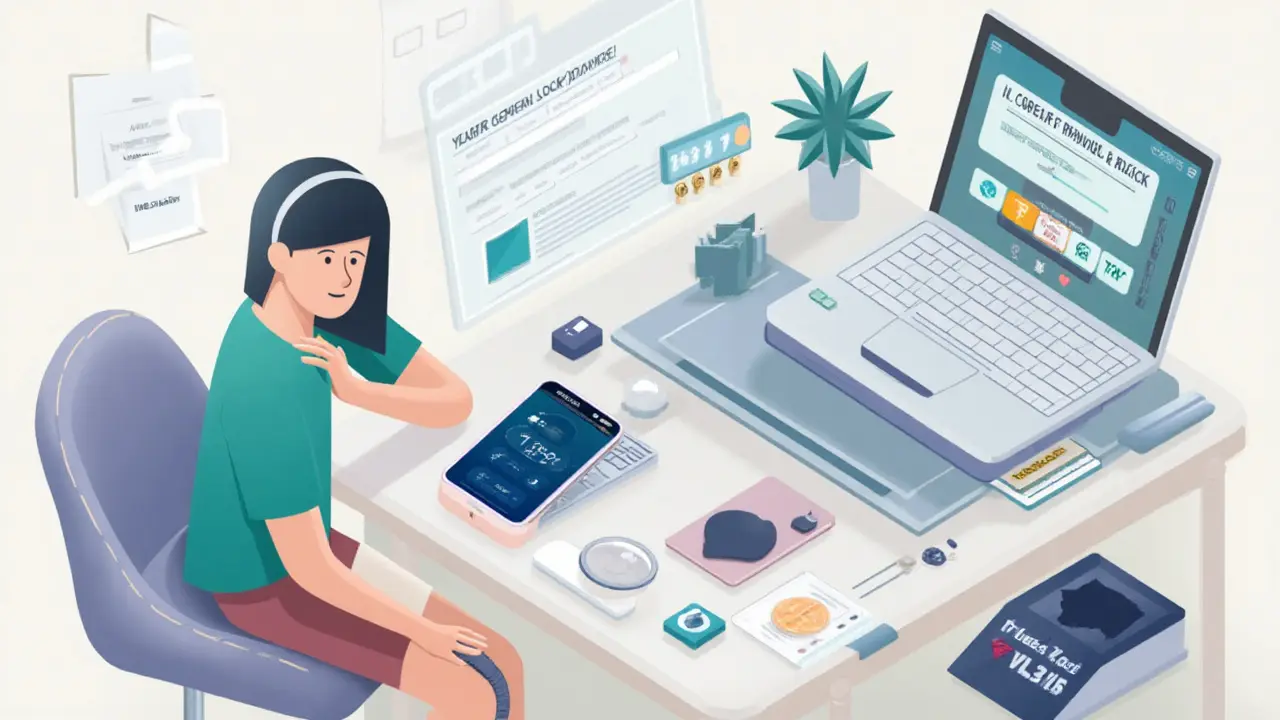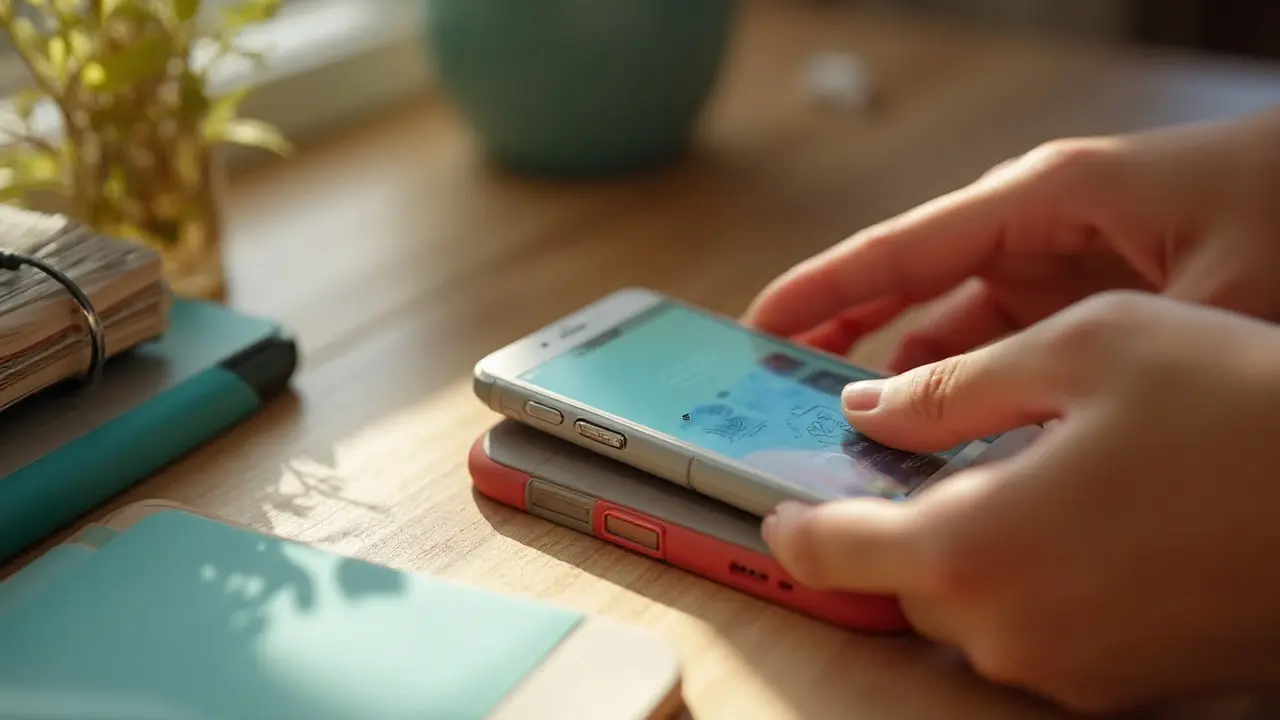You have a small window-often minutes-before a thief kills your signal or signs out of your accounts. Move fast. The goal is simple: lock it, track it, protect your stuff, then make the calls that matter.
First, try to ring it. Call your number from another phone and let it ring for a while. If someone honest picked it up at a cafe or gym, they might answer. I’ve had mine slide under Milo’s car seat and only the ringer saved me from a meltdown.
Next, open your phone’s tracker. On iPhone: use the Find My app on another Apple device or go to iCloud.com/find. On Android: use the Find My Device app on another phone or go to android.com/find. If your phone is nearby, hit Play Sound. If it’s not, turn on Lost Mode (iPhone) or Secure Device (Android) to lock it and show a message with a contact number.
Good to know: both Apple’s Find My network and Google’s Find My Device network can help find phones even when they’re offline by using nearby devices. So don’t give up if it shows as offline-mark it as lost and keep checking. If the dot is moving, don’t chase it. Meet police if recovery needs in-person help.
Can’t see it on the map? Assume risk and protect your accounts. Change your Apple ID or Google account password first; that cuts off access to iCloud, Photos, Gmail, and your app tokens. Then change passwords for email, banking, and any app that can spend money (Amazon, Uber, PayPal). If you use a password manager, sign in on another device and revoke the lost phone’s access.
Lock down your SIM. Call your carrier and ask them to suspend the line and block SIM swaps. This stops SMS codes from being hijacked. If they support it, ask for an IMEI block to make the phone unusable on local networks.
Remote wipe is your last resort. If you’re sure it’s gone, erase the device from Find My or Find My Device. On iPhone, Activation Lock still deters reuse. On Android, a factory reset protected by your Google account also limits resale. Just know: after a remote wipe, live tracking usually stops.
While you wait, check likely spots. Open your location history (Google Maps Timeline or the Find My “Last Known Location”) to see where it last pinged. Retrace the last hour: pockets, car seat gaps, stroller basket, couch cushions, checkout counter.
If you think it was stolen, file a police report and note the IMEI/serial (it’s on the box, your carrier bill, or your online account). Some insurers and carriers need a report number before they’ll help.
- Lock and Locate
- Call the Right People
- Secure Accounts and Money
- Recover and Document
- Prevent the Next Loss
Lock and Locate
This part is about speed. The goal is to lock your lost phone, make it ring if it’s nearby, and get a live pin on a map without tipping off whoever has it.
Grab any other device. A friend’s phone, a tablet, or a laptop works. You just need a browser or the official tracking app.
Try a quick ring. Call your own number or use the built‑in “Play Sound” feature below. Both iPhone and Android will ring even if the phone is on silent or vibrate.
Open the tracker that matches your phone:
iPhone: Find My app on another Apple device, or go to iCloud.com/find and sign in with your Apple ID.
Android: Find My Device app on another Android, or go to android.com/find and sign in with your Google account.
On iPhone (iOS 13+):
Find My > Devices > select your iPhone.
Hit Play Sound if it’s somewhere close.
Tap Mark As Lost (called Lost Mode on the web). This locks the phone with your passcode, disables Apple Pay cards, and lets you show a message plus a callback number on the lock screen.
Turn on Notify When Found. If the phone reconnects, you’ll get an alert.
Useful facts for iPhone:
Find My network can show location even if your iPhone is offline by using encrypted pings from nearby Apple devices (enabled by default on most recent setups).
Send Last Location (Settings > Apple ID > Find My > Find My iPhone) makes the phone upload its last known spot when the battery is critical.
After you erase the device remotely, you usually can’t keep tracking it. Activation Lock still prevents someone else from reactivating it without your Apple ID.
On Android (Android 9+):
Open android.com/find or the Find My Device app and pick your phone.
Tap Play Sound for a loud ring.
Tap Secure Device. This locks the phone, signs out of your Google account on that device, and lets you show a message plus a number on the lock screen.
If recovery looks unlikely, Erase Device is the nuclear option. Like iPhone, location tracking usually stops after a full wipe.
Useful facts for Android:
Google launched the Find My Device network in April 2024 in the U.S. and Canada, which helps find phones offline using nearby Android devices via encrypted Bluetooth signals.
Pixel 8 and 8 Pro can be located even when powered off, thanks to specialized hardware that keeps low‑power Bluetooth available for the network.
If it’s nearby but hiding:
Use Play Sound. It overrides silent mode on both platforms.
Have an Apple Watch? Swipe up for Control Center and tap the iPhone ping button. Press and hold to also flash the iPhone’s LED-handy in dark rooms or car footwells.
Check typical traps: couch gaps, coat pockets, car seat rails, gym lockers, stroller baskets.
If the map pin is moving or shows a sketchy spot:
Do not confront anyone. Share the location with local police and meet them instead.
Grab a screenshot with the timestamp and address-useful for reports and insurance.
Can’t see it online?
Keep Lost Mode/Secure Device on and leave Notify When Found enabled. Location can pop in later when the phone gets power or signal.
Check Google Maps Timeline on a computer (if Location History was on) for the last ping-sometimes it shows the last place you had the phone before it went offline.
One last guardrail: avoid hitting Erase too early. As long as the phone is locked and marked lost, your data is encrypted and Apple Pay/Google Pay are disabled. Keeping it trackable for a few hours can be the difference between getting it back and writing it off.
Call the Right People
After you lock and try to locate the device, start calling. The right calls, in the right order, can shut down fraud, speed up recovery, and make any insurance claim smooth. If you only remember one thing, call your carrier fast. A lost phone without a working SIM is a lot less useful to a thief.
“Call your wireless provider right away if your phone is lost or stolen.”
Federal Communications Commission (FCC)
Why lead with your carrier? In the U.S., carriers can suspend your line to stop calls, texts, and SMS 2FA codes, and they can flag your IMEI so it can’t be reactivated on participating networks. All major U.S. carriers share a stolen-device blacklist through the CTIA/GSMA system (you can check status at stolenphonechecker.org). Lock/locate first if you still see it on a map, then call to suspend the line and add port-out protection.
Call your carrier (mobile provider).
- What to ask: Suspend the line immediately; block SIM swaps/number port-outs; add the device’s IMEI to the stolen/lost database; add or confirm your account PIN/port freeze.
- How to reach: In the U.S., you can usually dial 611 from another phone on the same network. Examples: AT&T (800‑331‑0500), Verizon (800‑922‑0204), T‑Mobile (800‑937‑8997). Google Fi: support via app or fi.google.com; phone 844‑825‑5234.
- Heads-up: Suspending the line stops cellular tracking, but the phone can still ping on Wi‑Fi if it comes online. Keep Lost Mode/secure lock on either way.
Call your banks and card issuers.
- What to ask: Disable mobile wallet tokens (Apple Pay/Google Wallet) for the missing device; monitor and freeze cards if needed; set fraud alerts.
- Useful facts: Apple Pay and Google Wallet use device-specific tokens. Killing those tokens does not close your card; it just stops taps from that device. You can also remove cards yourself from iCloud.com (Apple ID > Devices) or pay.google.com (Payment methods > Devices).
- Liability basics (U.S.): Under the Fair Credit Billing Act, your max liability for unauthorized credit card charges is $50 and most issuers offer zero liability. Under Reg E for debit cards, report within 2 business days to cap losses at $50; after that it can rise to $500, and after 60 days it can be unlimited.
Call your employer’s IT desk (if it’s a work or BYOD phone).
- What to ask: Revoke company email and VPN access; wipe corporate data via MDM (e.g., Intune, Jamf); rotate any app tokens.
- Tip: IT can usually do a “selective wipe” that removes work data without touching your personal photos.
Call your insurance.
- What to ask: Start a claim and confirm deadlines and deductibles. If you have AppleCare+ with Theft and Loss, Find My must have been enabled at the time of loss and the device should be in Lost Mode for the claim. Carrier insurance (often Asurion) may require a police report.
Call the place you last had it.
- Venues: Store, gym, school office, front desk, airline/airport lost and found.
- Rideshare: Uber and Lyft both have in‑app “Find lost item” flows that let you contact the driver. Uber can place a call to your number on the driver’s phone.
Call local police (if you suspect theft).
- What to provide: IMEI/serial, last known location/time, case number for insurance. Don’t chase a moving dot-meet officers instead.
Have this info ready before you dial:
- Account details: your phone number, account PIN/passcode, and billing ZIP.
- Device identifiers: IMEI/IMEI2 (for dual eSIM) and serial. You’ll find these on the box, your carrier portal, Apple ID device list (appleid.apple.com), or sometimes on past repair invoices.
- Timeline: last known location/time, what you already did (Locked, Lost Mode, attempted wipe).
Extra security you should request while you’re on the phone with your carrier:
- Port-out protection/number lock (stops someone from moving your number to another SIM without a special PIN).
- Account takeover protections (unique passcode for in‑store changes; no SIM replacements without government ID plus your passcode).
| Who to contact | Primary goal | Best way to reach | What to ask for | What you’ll need |
|---|---|---|---|---|
| Mobile carrier | Suspend line; block SIM/port; blacklist IMEI | Dial 611 (U.S.); AT&T 800‑331‑0500; Verizon 800‑922‑0204; T‑Mobile 800‑937‑8997 | Line suspend; port freeze; IMEI block; add/confirm account PIN | Phone number, account PIN, IMEI |
| Bank/card issuer | Kill wallet tokens; watch charges | Number on back of card; in‑app support | Remove tokens; monitor/freeze card; set fraud alerts | Last 4 digits, recent transactions |
| Employer IT (MDM) | Revoke work access; wipe work data | Help desk or IT ticket | Selective wipe; reset SSO/2FA | Work email, device model |
| Insurance | Start claim | Carrier insurance portal; AppleCare+ claims site | Confirm deductible, deadlines, docs | Police report #, IMEI, proof of purchase |
| Venue/transport | Recover device if found | Store/gym front desk; airport L&F; Uber/Lyft in‑app | Log item with time/place; contact driver | Time window, description, contact # |
| Police (if theft) | Official record; safety | Non‑emergency line | File report; don’t pursue alone | IMEI/serial, last location, photos/box |
A few concrete tips that pay off:
- Ask your carrier to read back the IMEI they blacklisted and note the case or ticket number. Keep it for insurance.
- If your number is used for SMS 2FA anywhere, switch those accounts to app‑based codes (Authenticator, 1Password, Authy) while your line is suspended.
- Removing cards from Apple Pay/Google Wallet is separate from suspending your line. Do both: carrier for the SIM, bank for the tokens.
- If you’re abroad, ask the carrier for an eSIM reissue to your spare/loaner phone so you can keep service while the old eSIM is killed.
Last thing: document everything-times you called, names of reps, case numbers. If charges pop up later, that log helps your bank, your carrier, and your insurer move faster.

Secure Accounts and Money
Your top priority is cutting off access to email, money, and text-based codes. If this is a lost phone, assume someone can guess your unlock code or swap your SIM. Move in this order so you don’t lock yourself out while shutting them out.
Change your Apple or Google account password first.
- Apple: appleid.apple.com → Sign-In & Security → Change Password. This immediately stops iCloud/iMessage/Keychain sync on the phone.
- Google: myaccount.google.com/security → Password. This kills Gmail/Drive/Photos and many app sessions on the device.
- Known fact: Changing your Apple ID or Google password revokes existing tokens, which blocks access to iCloud/Google services on that phone, even if it’s still unlocked.
Force sign-outs and remove the phone from your account.
- Apple: iCloud.com/find → mark as Lost; then appleid.apple.com → Devices → select the missing iPhone → Remove from account (after remote erase) to keep it from re-signing in.
- Google: myaccount.google.com/device-activity → select the phone → Sign out. This cuts access for Gmail, YouTube, Maps, etc.
- Work devices: tell IT. Mobile device management (MDM) can remotely wipe corporate profiles and revoke email/VPN.
Shut down wallets and payment apps.
- Apple Pay: marking iPhone as Lost in Find My automatically suspends Apple Pay on that device. You can also remove cards at appleid.apple.com → Devices → select device → remove cards.
- Google Wallet: go to pay.google.com → Payment methods → Remove cards from the missing device. Removing the device in myaccount.google.com also helps.
- Amazon/PayPal/Venmo/Cash App/Uber: change the password, turn on 2-step verification, and check recent transactions. PayPal has Settings → Security → Manage your devices → Log out.
Lock your phone number to stop SIM swaps.
- Call your carrier to suspend service. Ask for a SIM swap/port-out lock.
- Verizon: “Number Lock.” T‑Mobile: “Account Takeover Protection.” AT&T: add “Extra security” and require a Number Transfer PIN. These blocks make it far harder to port your number without you.
- Why this matters: many banks still send one-time codes over SMS. If a thief ports your number, they can intercept those codes.
Secure email next (it’s the reset key to everything).
- Change the password and enable 2FA (prefer app-based).
- Check forwarding rules and filters (attackers often add a secret forward or delete rule to hide alerts). In Gmail: Settings → See all settings → Forwarding and POP/IMAP → Forwarding. In Outlook.com: Settings → Mail → Forwarding/Rules.
Triage your password manager and authenticators.
- Password managers (1Password, Bitwarden, LastPass): deauthorize the missing device from your account dashboard. If your master password might be known, change it and rotate critical passwords (email, bank, wallet first).
- Authenticator apps: if you use Google Authenticator with cloud sync, remove the lost device from your Google Account; for Authy, disable “Allow Multi-device” and remove the device via another trusted device or contact support; for Microsoft Authenticator, go to account.microsoft.com/security → Advanced security options → remove the lost sign-in method.
- Have backup codes? Store them somewhere offline (not on the replacement phone yet).
Call banks and card issuers.
- Ask for a temporary freeze or new card numbers and review recent charges. Debit cards hit your cash balance; credit cards have stronger protections.
- If your banking app was logged in on the phone, tell them exactly which device is missing and when. Many banks can instantly deauthorize a device.
Two quick realities worth knowing:
- iOS 17.3+ “Stolen Device Protection” requires Face/Touch ID (no passcode fallback) to access sensitive settings away from familiar locations, and adds a 1‑hour delay to change your Apple ID password or security settings. That helps, but you should still change your Apple ID password right away.
- Android’s Factory Reset Protection (FRP) requires the previous Google account after a reset. It deters resale, but it doesn’t protect data if the device is unlocked-your account resets do.
Reporting timelines affect your money. Here are the standard liability rules in the U.S. for unauthorized transactions (not scams you approved):
| Account/Method | Law/Policy | Report within 2 business days | After 2 business days | After 60 days of statement |
|---|---|---|---|---|
| Debit card/Bank account (ATM/ACH) | Regulation E (EFTA) | Max $50 liability | Up to $500 | Unlimited on subsequent unauthorized transfers |
| Credit card | Fair Credit Billing Act + network zero‑liability (Visa/Mastercard/Amex/Discover) | Typically $0 (zero‑liability); legal cap $50 | Typically $0 (if reported promptly) | Typically $0 (zero‑liability still applies) |
| Apple Pay / Google Wallet (card tokenized) | Issuer’s card rules apply | Treated like card fraud; usually $0 under zero‑liability | Same | Same |
| P2P transfers (Zelle, Venmo, Cash App) | Varies: unauthorized transfers covered by Reg E; authorized scams usually not | Report ASAP for best chance of reimbursement | Harder to recover | After 60 days, recovery is unlikely |
Practical checklist you can work down right now:
- Apple or Google password changed, device marked Lost, remote wipe queued.
- Carrier suspended line and enabled SIM swap/port-out lock.
- Email password changed, forwarding rules checked, 2FA switched to an authenticator app.
- Wallet cards removed from the missing phone; payment apps password-changed and reviewed.
- Password manager device deauthorized; critical passwords rotated; backup codes stored offline.
- Banks and card issuers called; fraud/chargeback process started if you see anything suspicious.
Last tip: once you’re stable, switch as many 2FA prompts as possible from SMS to an authenticator app or a hardware key, and keep printed backup codes in a safe place at home. It’s boring prep, but it turns a phone loss from a panic into an inconvenience.
Recover and Document
You’ve locked things down. Now switch to recovery mode and build a clean paper trail. This is how you turn a lost phone into a documented case an insurer, venue, carrier, or police department can act on.
Retrace with data, not guesses. Check your tracker’s “last seen” and turn on Notify When Found. iPhone: Find My > your device > Activate Mark As Lost and enable notifications. Android: Find My Device > Select device > Secure Device and keep refreshing. If you had Google Location History on, open timeline.google.com to see time-stamped pings along your route.
Call the places you were in the last hour. Start with checkouts, coffee shops, gyms, rideshares, and transit. Uber: Help > I lost an item > Contact driver (Uber may charge a small return fee in many U.S. cities). Lyft: Help > Lost and Found > Contact driver. Ask businesses about their lost-and-found log and whether a manager can quickly review cameras for the time window you give them.
Grab your device IDs (you’ll need these for reports and blocks). IMEI/serial are on: the original box; your carrier bill/online account; Apple: appleid.apple.com > Sign in > Devices > pick your iPhone to see serial/IMEI; Google: myaccount.google.com > Security > Your devices (device details). If you still have another phone, dialing *#06# on the same model won’t help now, but it’s a good habit to note the IMEI for your current device next time.
File a police report if you suspect theft or can’t locate it. Use your city’s non‑emergency/online form. Include: make/model/color, IMEI/serial, last known time and location, case notes (e.g., tracking screenshots), and your contact number. Don’t try a face-to-face recovery; if the map is moving, share the report and location with police.
Ask your carrier to block the IMEI and suspend the line. In many countries, carriers use the GSMA global IMEI blacklist to deter reuse. In the U.S., you (or a buyer) can verify block status at the CTIA’s Stolen Phone Checker (stolenphonechecker.org). Request a new SIM/eSIM and set a port‑out PIN to prevent SIM‑swap.
Start your insurance or protection claim. Have ready: the police report number, proof of purchase, IMEI/serial, and a short timeline of events. AppleCare+ with Theft and Loss requires that Find My was enabled on the device at the time of loss-Apple checks this during a claim. For carrier insurance, begin the claim process as soon as you have the report number.
Handle work devices right away. Email IT with the device name, line, and last seen time. Most companies use MDM (Jamf, Intune, MobileIron) and can lock/wipe and produce audit logs you can reference in your claim.
Clean up payments and passes. When you put an iPhone in Lost Mode, Apple Pay on that device is automatically suspended; you can also remove cards at appleid.apple.com. On Android, remove Google Pay cards at pay.google.com and call your bank to reissue any card you suspect is exposed. Replace transit cards or badges that were stored in Wallet/Pay.
Document everything in one note. Create a single doc with: timestamps of actions you took, screenshots of trackers, support case numbers, police report number, IMEI/serial, and who you spoke with (name, department, callback). Share it with a family member in case someone needs to make calls for you.
Watch for phishing. Thieves often text “Your phone was found-log in here” with a fake link. Real Apple/Google pages are icloud.com/find, appleid.apple.com, android.com/find, or links that keep you on those domains. If in doubt, type the address yourself-don’t tap.
Reference sheet: features that help recovery and your documentation.
| Platform | Feature | Year introduced | What it does | Where you use it |
|---|---|---|---|---|
| Apple (iOS) | Activation Lock (Find My) | 2013 (iOS 7) | Prevents reactivation without the owner’s Apple ID after erase/reset. | Find My app, icloud.com/find |
| Apple (iOS) | Powered‑off finding (supported models) | 2021 (iOS 15) | Can show location even when the phone is powered off. | Find My app, icloud.com/find |
| Android | Factory Reset Protection (FRP) | 2015 (Android 5.1) | Requires the linked Google account to set up after a reset. | Automatic when a Google account is on the device |
| Android | Find My Device network | 2024 (rollout in U.S./Canada) | Uses nearby Android devices to locate phones even when offline. | Find My Device app, android.com/find |
Once these steps are done, you’ll either get a call when it turns up, have enough detail to recover it with help, or have the paperwork to replace it fast.

Prevent the Next Loss
If you spend 10 minutes on setup today, a future lost phone becomes an annoying errand, not a crisis. The play is simple: harden the lock screen, turn on real tracking, protect your accounts, and make sure you can recover fast.
Start with a serious lock. A six-digit PIN is the bare minimum; a longer alphanumeric passcode is better. Shoulder-surfing is a real thing-thieves watch you type your code, then grab the phone. If they have your passcode, they can change account settings unless you add extra protections below.
| Passcode type | Possible combinations | Increase vs 4-digit |
|---|---|---|
| 4‑digit PIN | 10,000 | Baseline |
| 6‑digit PIN | 1,000,000 | 100× |
| 8‑digit PIN | 100,000,000 | 10,000× |
| 8‑char alphanumeric | Billions+ (depends on charset) | Massively higher |
Turn on the built-in recovery and anti-theft tools. These are not optional-they decide whether you can lock, find, and wipe your phone when it’s offline or stolen.
- iPhone: Settings > [your name] > Find My > Find My iPhone: On. Also enable “Find My network” and “Send Last Location.” iOS 17.3 and later adds Stolen Device Protection (Settings > Face ID & Passcode) which forces Face ID/Touch ID and adds a security delay for sensitive changes when you’re away from familiar locations.
- Android: Settings > Security & privacy > Find My Device: On. In 2024, Google launched the Find My Device network that can locate some devices and accessories even when they’re offline using nearby Android phones. Look for “Find your offline devices” options when available. Google also started rolling out “Theft Detection Lock” in 2024, which can auto-lock if it detects a snatch-and-run motion (availability varies by device/region; check Security settings or Google Play Services release notes).
Lock down the SIM. A SIM PIN stops someone from popping your SIM into another phone to hijack SMS codes.
- iPhone: Settings > Cellular > SIM PIN.
- Android: Settings > Security & privacy > More security > SIM lock (wording varies by brand).
Hide sensitive stuff on the lock screen. You don’t want your messages, MFA codes, or wallet shortcuts visible before unlocking.
- iPhone: Settings > Notifications > Show Previews > When Unlocked. Also in Settings > Face ID & Passcode, turn off lock screen access for Control Center, Wallet, USB Accessories, and any features you don’t need before unlocking.
- Android: Settings > Notifications > Lock screen > Hide sensitive content (names vary). In Security settings, look for “Secure lock settings” or similar to limit power menu or quick settings on the lock screen (options vary by brand).
Make it easy for a good person to reach you without unlocking. On iPhone, add emergency contacts (Health app > Medical ID) which are visible from the lock screen. On Android, add a lock screen message with an email or alternate number (Settings > Security & privacy > Lock screen message).
Turn on automatic backups. If you have to wipe the phone, you won’t lose memories or messages.
- iPhone iCloud Backup: Settings > [your name] > iCloud > iCloud Backup: On. iCloud backs up when the phone is plugged in, locked, and on Wi‑Fi. You can also enable cellular backup on supported 5G plans.
- Android Backup: Settings > Google > Backup (or Settings > System > Backup): On. Android backs up apps, photos (if you use Google Photos), call history, SMS (on many devices), and settings when charging and on Wi‑Fi.
Protect accounts like a hawk. This blocks the “change your passwords and take over everything” move if someone sees your passcode.
- Use app-based 2FA or passkeys for email, bank, and password manager. Prefer authenticator apps (or built-in passkeys) over SMS.
- Store and test recovery methods now: Apple Recovery Key or Recovery Contact (Settings > [your name] > Sign-In & Security), and Google recovery phone/email plus backup codes (myaccount.google.com/security).
- Keep your password manager logged in on a second device (laptop or tablet) so you can revoke sessions fast if the phone goes missing.
Record the numbers that matter and stash them somewhere you can reach from any browser.
- Find your IMEI/serial: dial *#06# or check Settings (iPhone: General > About; Android: About phone). Save this in your password manager.
- Carrier support number (to suspend service and request an IMEI block) and device purchase details (for insurance claims).
Add a tracker to what you actually carry. A phone case with a lanyard or a small Bluetooth tracker in your bag can save you hours.
- Apple users: an AirTag in your bag or car keys rides the Find My network, which uses nearby Apple devices to update location even when your tag has no internet.
- Android users: the updated Find My Device network supports compatible tags from brands like Chipolo and Pebblebee (2024 rollout). Pair one to your keys or backpack.
Use family features so someone you trust can help fast.
- iPhone: Family Sharing lets trusted family members locate devices via Find My (with your permission). You can also share your location by default with specific people.
- Android: Google Family Link allows location sharing and basic device management for kids’ devices. Adults can share locations in Google Maps.
Do a quick drill once. It’s five minutes, and you’ll thank yourself later.
- From a laptop, sign in to iCloud.com/find or android.com/find. Make sure you can see your phone on the map.
- Play a sound, then cancel it. Practice “Mark as Lost”/“Secure Device” but stop just before confirming, so you know the flow.
- Confirm you can change your account password quickly and find your 2FA backup codes.
Last tip: keep your phone in a zipped pocket or crossbody bag in crowds, use the wrist lanyard when snapping photos, and avoid typing your passcode in public if you can use Face ID/Touch ID instead. Small habits beat heroics.




